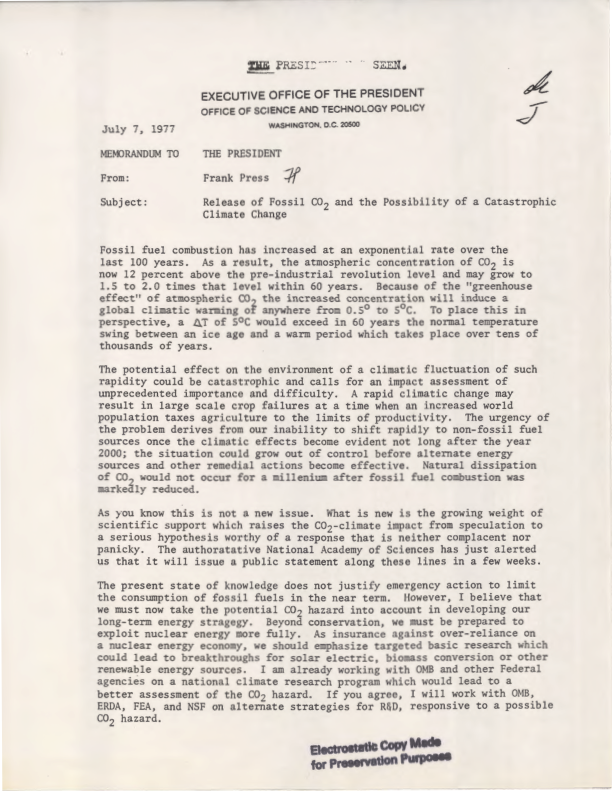A memo outlining the ‘catastrophic’ threat posed by fossil fuels in the area of climate change was seen by U.S. President Jimmy Carter in 1977.
In July the Democrat candidate had only been in office for seven months, but was know to be concerned about environmental issues.
The former peanut farmer turned President was ahead of his time, ordering the installation of solar panels on the White House, as well as announcing a National Renewable Energy Plan .
‘We must start now to develop the new, unconventional sources of energy we will rely on in the next century,’ he had said in an address to the nation.
The climate change memo arrived on his desk with the title ‘Release of Fossil CO2 and the Possibility of a Catastrophic Climate Change’. On it is a stamp, saying THE PRESIDENT HAS SEEN (although this is partially obscured).

The memo’s author was Dr Frank Press, who had been director of the Seismological Laboratory at the California Institute of Technology, and worked as a consultant for the U.S. Navy and NASA.
Foresight
President Jimmy Carter named Dr Press, who died two years ago aged 95, Director of the Office of Science and Technology Policy in 1977. In that role he was the President’s top science adviser, concerned with ensuring that the U.S. stayed at the forefront of global scientific research.
‘The urgency of the problem derives from our inability to shift rapidly to non-fossil fuel sources once the climatic effects become evident not long after the year 2000.’
Dr Frank Press, Director of the Office of Science and Technology Policy in 1977
Dr Press stated: ‘Fossil fuel combustion has increased at an exponential rate over the last century . As a result, the atmospheric concentration of CO2 is now 12 percent above the pre-industrial revolution level and may grow to 1.5 to 2.0 times that level within 60 years.
‘Because of the ‘greenhouse effect’ of atmospheric CO2 the increased concentration will induce a global climatic warming of anywhere from 0.5 to 5°C.’
Dr Press went on to write: ‘The potential effect on the environment of a climatic fluctuation of such rapidity could be catastrophic and calls for an impact assessment of unprecedented importance and difficulty.
‘The urgency of the problem derives from our inability to shift rapidly to non-fossil fuel sources once the climatic effects become evident not long after the year 2000; the situation could grow out of control before alternate energy sources and other remedial actions become effective.’
However the memo did also state: ‘The present state of knowledge does not justify emergency action to limit the consumption of fossil fuels in the near term. However, I believe that we must now take the potential CO2 hazard into account in developing our long-term energy strategy.’
And alongside Press’s memo on the president’s desk, Jim Schlesinger, America’s first secretary of energy, also attached his own note. It stated: ‘My view is that the policy implications of this issue are still too uncertain to warrant Presidential involvement and policy initiatives.’
Jimmy Carter – The Green President?
President Carter did sign some environmental legislation, including establishing the first federal toxic waste cleanups and creating the first fuel economy standards. Through the Alaska National Interest Lands Conservation Act, he doubled the national park system and conserved over 100 million acres of land – the largest expansion of protected landscape in U.S. history.

However he also worked to boost U.S. oil production in order to reduce dependence on imports in the wake of the 1973 oil crisis – which saw purchases at garages restricted to 10 gallons of petrol.
James Gustave Speth served as the chairman of President Carter’s Council on Environmental Quality and helped brief him on climate change. Speaking last year he compared his former chief to another ex-U.S. President – Donald Trump.
He said: ‘Carter was the opposite of Trump – and everything that people despised about him. Carter had integrity, honesty, candor and a commitment to the public good of all else. Carter was a different man, totally.
‘Carter was our only president who had a visceral environmental and ecological attachment. That was part of his being. We had an opportunity in 1980 – but we’ve lost 40 years in the pursuit of a climate-safe path. We can no longer avoid serious and destructive changes, period. That didn’t have to happen.’
Any further environmental action was halted in its tracks in 1981 when Ronald Reagan was elected President.
After installing himself in the White House the new president ordered its solar panels be removed and went on to become an enthusiastic supporter of the oil and gas industry.
However the fossil fuel business did take note of the warnings – and started spending millions of dollars on discrediting climate change science.













